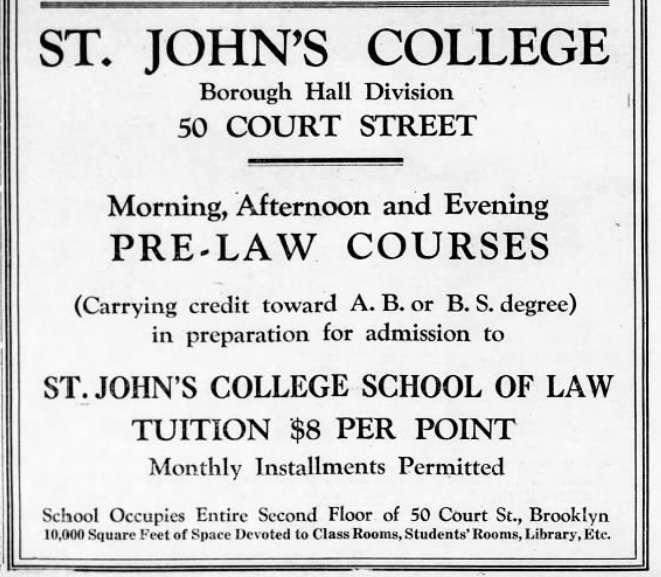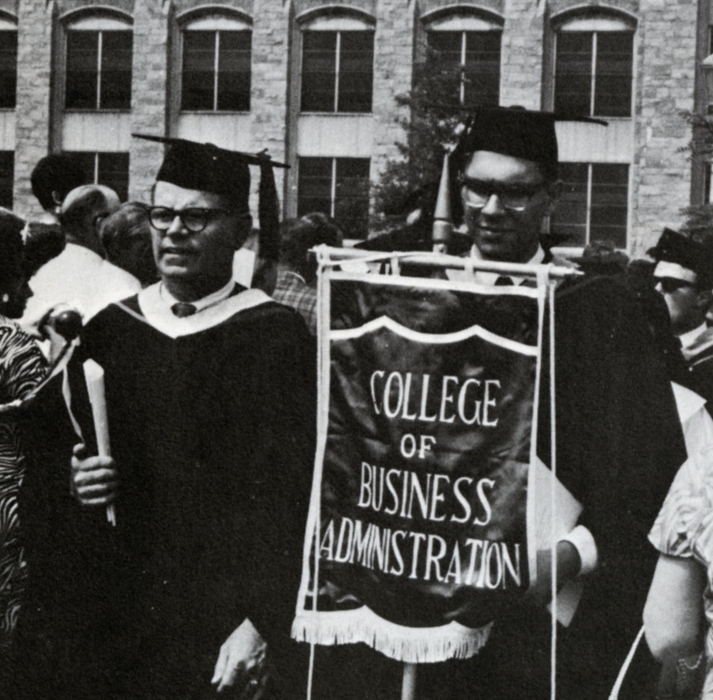- Home
- Digital History Exhibit
- The Professional Colleges
Digital History Exhibit
- Bishop Loughlin's Vision and the Vincentian Mission
- Catholic Education
- Places of Worship
- Charity and Service
- Brooklyn Campus History
- Queens Campus History
- Staten Island Campus History
- Manhattan Campus History
- Long Island and International Location History
- Student Organizations
- The Campus Experience
- Student Publications
- The Early Colleges
- The Newest Colleges
- The Professional Colleges
- The Libraries and Archives
School of Law, 1925
In September of 1925, the Torch newspaper reported that the newly founded St. John’s School of Law had reached their limit of 800 applications within just four months for entrance into the first academic class, and even still, “applications have kept pouring in without stop until at present there is a waiting list of four or five hundred.” The School of Law began in the Terminal Building, at 50 Court Street in Brooklyn, but soon moved to the newly constructed downtown Brooklyn campus at 96 Schermerhorn Street in November 1928, and finally moved to the Queens campus in Fall 1972. Today, the School of Law is the third-oldest of the schools and colleges within St. John’s University.
This clip from “Education for Living,” a promotional video produced by St. John’s University in 1953, highlighted several schools and colleges, including the Law School. The Law Library, the Moot Court, and the student published “St. John’s Law Review” are all featured.
University College, 1927
In 1927, St. John’s founded two new colleges: University College, and the School of Accounting, Commerce, & Finance. These two colleges greatly expanded the course offerings available to students in the professional disciplines.
University College began under the name “St. John’s College, Borough Hall Division,” and served as a pre-law program to ready students for entrance into the St. John’s School of Law with one year of college coursework. In 1932, the Brooklyn Daily Eagle announced that a four-year course of study would be offered for the first time in the Arts and Sciences department of the Borough Hall Division. In 1942, this school was renamed “University College.” The administrations of the University College (Schermerhorn Street campus) and the St. John’s College of Liberal Arts and Sciences (Lewis Avenue campus) were later combined in 1959. In 1971, University College closed at the same time as the closing of the Schermerhorn Street campus.



School of Accounting, Commerce, & Finance, 1927
The School of Accounting, Commerce, & Finance also opened in 1927, offering courses in business administration, accountancy, business law, and economics. In 1933, the name was shortened to the School of Commerce, and in 1961, it became the College of Business Administration. In 2000, the college was renamed the Peter J. Tobin College of Business, which today offers a wide variety of majors in fields such as business analytics, marketing, and risk management & insurance, as well as M.B.A. offerings for graduate students.




College of Pharmacy, 1929
The College of Pharmacy was the fourth and final college founded during the very busy 1920s at St. John’s University. It began in 1929 at the Schermerhorn Street campus in Brooklyn, and was relocated to the Queens campus in St. Albert Hall, the “Science-Pharmacy” building, upon its completion in 1958.
This 1953 video clip from “Education for Living” shows color footage of students in the Brooklyn campus pharmacy laboratories and the “completely stocked pharmacy, furnished and managed exactly as the neighborhood drugstore on the corner.”
School of Nursing Education, 1937
In 1937, a Department of Nursing was formed within the School of Education. The department became a separate School of Nursing Education in 1942, helping to train nurses during World War II. In 1958, the School again became a Department under the School of Education, finally closing in 1966. This video clip from 1953 highlights the Nursing Education program, as well as the school’s health counseling services and emergencies facilities.
